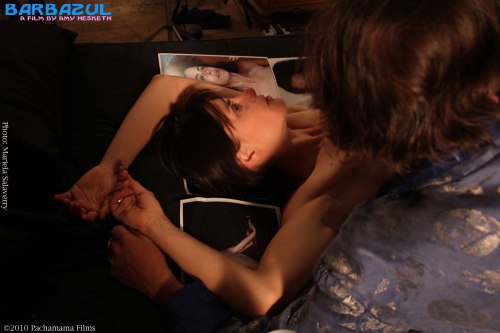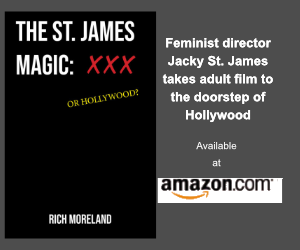by Rich Moreland, November 2020
I came to Martyr late (is was released almost twenty years ago) but my friendship with its creator, Jac Avila, led to this commentary.
For a substantial overview of the film which is not included in this discussion, go to Ralphus.net for JoeKO’s summary.
In the sources for this commentary, I’ve also included references to reviews by Amy Hesketh (Transformation and catharsis in Jac Avila’s Martyr, August 29, 20110), Charles Lonberger (Review: Martyr or the Death of St. Eulalia, January 15, 2014) and C Dean Andersson (The Fascination of Fear versus the Beauty of Horror , 17 November 2012).
And, of course, there are the words of Jac himself to help us understand what Marytr is all about.
* * *
How Martyr came to be centers on two actresses, Carmen Paintoux and her sister Veronica, a friendship director Jac Avila nurtured over twenty years ago.
As the 20th century was winding down, Jac spent time in New York and France before going back to Bolivia in 1992. “That’s when I met Carmen and Vero,” he explains. Later, Jac recalls, “I returned to live in New York with Carmen in 1997. Vero joined us in NY in 1998.”
Martyr, shot in 2002, made its way into the public arena in 2005.
With that bit of a background, I’ll turn to Joek0’s essay for an overview of the film.
“We are introduced to the lovely young French couple of Camille (Carmen Paintoux) and Julien (Mickael Trodoux). Camille tells the story of Eulalia, a beautiful female virgin martyr. We also meet Julien’s American friend Dave (Erik Antoine) who loves messing around with a bullet-less gun.”
The gun is a vital image in the film, as we see in the ending. This is not a spoiler alert, however, you will have the see the movie for yourself to properly judge everyone’s actions.
For now, back to Joek0’s description.
“Camille is bored of doing nothing while staying with her boyfriend in order to help out his career.” Eventually, she encounters Tadeusz, “a photographer who really lets her act out the great story of the martyr St. Eulalia.”
(As he so often does, Jac plays the role of Tadeusz, the dominant/sadist in the film).
Joek0 concludes. “We see Camille suffer for her art and her passion, but she also feels empowered” in a story laced with “jealousy” since “many of the films relationships [are] tested.”
Catholicism and the Female Body in Pain
Jac explains how his interest in female crucifixion films came to be. Raised as a Catholic and attending Catholic schools forged a background that, to some degree, led him to filmmaking.
“Catholic imagery is full of The Body in Pain,” Jac begins, “a beautiful body, always . . . almost nude or totally nude, with an expression of bliss in the very moment of martyrdom. The school I attended was full of those images. Beautiful paintings expressing exactly that.”
Next, he references an eye-opener for many non-Catholics. “Catholicism is far less repressed sexually” than other forms of Christianity, he says. In subsequent films shot under the production banner of Pachamama Films, Jac emphasizes what many of his fans interpret as the sexual kinks of bdsm—female whipping scenes and crucifixion—are integral to much of his work.
However, beneath that all-to-convenient analysis, is the profound issue of female empowerment, something that seems, at least on the surface, to be contradictory to those whose religious faith is contextually male-oriented.
“In Catholicism women have a high place because of the Virgin. The Mother of God herself. Catholicism is not as patriarchal as it may seem to be . . . women, just like men, have the same or more capacity to suffer for humanity,” Jac asserts.
“In that sense, female martyrdom gets equal treatment . . . or better yet, takes the main role. The strongest character in Catholicism is Saint Eulalia, who is stronger than any of the other female martyrs. She’s crucified twice.”
Thus, the concept of Martyr came to be.
But, does making a film that borders on realism about a tortured Saint present issues that can turn off many female performers, considering the physical discomfort their acting involves?
Actually, Jac states, for the right personalities, it is an invigorating experience.
“Acting in these movies is, in a sense, empowering,” he says. “The actress has complete control over her body, mind, soul, to do anything she wants to do.”
In other words, female emancipation, if we can call it that, and the assertion that women are on a basis equal to men drives all of Jac’s films. For Martyr, feminism framed by religion is an unparalleled cinematic example.
Old Havana
Jac offers us a background glimpse into the events that led to Martyr.
Though he spent time in Bolivia as a youth, he relates that he primarily lived in New York where he “studied film, worked at CBS [and] did commercial photography.”
Eventually his filmmaking took him south again. “I made a film in Haiti and Cuba, documentaries and miniseries in Bolivia, including one for National Geographic. I premiered my first film at Cannes in 1988.”
In the early 1980s, Jac spent a couple of years in Cuba involved in working through the bureaucratic morass needed to make a film. Progress was slow.
“With so much time in my hands I read a lot,” he explains. “One of my favorite past times was to visit the bookstores in ‘charming Old Havana,’ searching for whatever I could find.”
One of the visits paid off handsomely.
“I found a beautiful book of Medieval Spanish Paintings, published in Hungary. One of the paintings was an altar piece dedicated to The Martyrdom of St Eulalia. In it, all the tortures the martyr went through were represented, including her double crucifixion. That was fascinating to me. Some short time before in New York, I came across the J. W. Waterhouse painting of St Eulalia. I was hooked on that martyr from then on. Needless to say, I researched all matters concerning this enigmatic young saint.”
From these revelations, the idea for a film was hatched.
Women United
Camille is the powerful figure of Martyr.
 Charles Lonberger states that Carmen Paintoux’s portrayal of Camille “merges the physical and the cerebral. She martyrs herself as her identity morphs into the Saint she is researching.”
Charles Lonberger states that Carmen Paintoux’s portrayal of Camille “merges the physical and the cerebral. She martyrs herself as her identity morphs into the Saint she is researching.”
Yet there are two more women who become feminist statements in the film. Elisa (played by Natacha Petrovich), “intends to be the St. Julia to Camille’s St. Eulalia,” Lonberger says, though “that assignment is actually assumed by Veronica Paintoux, in the role of Gabrielle, for which she is rewarded by being lanced and hung on a cross, as well.”
For Carmen Paintoux, playing Camille was no easy task.
Nevertheless, C Dean Andersson is impressed with her performance.
“While seemingly headed in a dangerous direction,” Camille “heroically [pulled] herself together by defying her inner coward and embracing urges she had previously avoided, because the more her flesh was tied and tormented, the freer and stronger her spirit somehow became.”
Then there is Gabrielle, Tadeusz’s live-in lover, who by the luck of the draw becomes Camille’s partner in pain.
Joek0 explains.
 “While Elisa is not really eager to be hung on a cross, she tries to show a brave face all along.” But soon it is evident that Gabrielle is convinced “to take her place.”
“While Elisa is not really eager to be hung on a cross, she tries to show a brave face all along.” But soon it is evident that Gabrielle is convinced “to take her place.”
It’s a turn of events that is totally unexpected “since Gabrielle did not like Camille stealing away the spotlight from her. But Gabrielle was finally moved by Camille passion for what this shoot really stood for. Gabrielle is ready to take her place on the cross.”
As the nails go into Camille’s legs, Joek0 continues, she “looks over to her side is glad to see that Gabrielle is right beside her to share the pain of her tortures. They are now true sisters in pain. Gabrielle is then impaled in the chest with a spear. She loudly screams in pain. They both fall into unconsciousness to the pain they suffered.”
Art
Filmmaker Amy Hesketh, joined with Jac Avila several years ago to begin an artistically productive period in both their lives. Eventually, she starred in prominent roles that have made Pachamama Films famous within its niche audience.
Jac recalls that Amy “was doing a lot of photography, not modeling, when we met in 2005. She saw Martyr in Oruro, of all places, and that’s when she decided to take the path I was on.”
In her essay on Martyr, Amy comments on the creative aspects of the film.
“Camille begins to know Eulalia, her pain, her suffering. The images are like paintings, they are beautiful to behold, and that beauty is emphasized by Camille’s contortions, the pain she evokes. Camille takes us along in her journey. The sounds make us flinch, but Camille is using the pain, the experience, for her own ends.”
Amy lets us in on how Camille triumphs through her self-imposed ordeal.
“The strain in her muscles and tendons evokes strength, resistance. She uses the pain to reach Eulalia, to force Eulalia into her body. To coerce a revolution in herself. She is coming into being.
“The end, the resolution, the catharsis is happening. Camille becomes… herself.”
 Of all the words written about Pachamama Films, that is the truest of feminist statements because it’s a rebirth which Amy Hesketh understands completely for it encapsulates the beauty of her performances in the remarkable films she and Jac created during their partnership.
Of all the words written about Pachamama Films, that is the truest of feminist statements because it’s a rebirth which Amy Hesketh understands completely for it encapsulates the beauty of her performances in the remarkable films she and Jac created during their partnership.
In the final analysis, Amy nails (no pun intended) Camille’s role in Martyr.
“And while we may think that personal striving for catharsis and change is narcissistic, the self is more complex than that. The people around us are affected, but can also be inspired. Changing ourselves may make us fit into the world in a different way, but maybe we fit a little better.”
No feminist—artistic, political, or otherwise—would disagree.
* * *

































